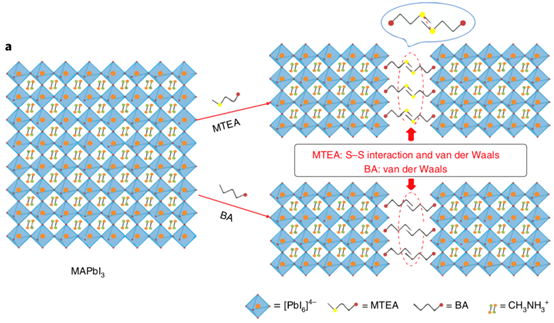Shidong Yu (Class of 2015, major in Materials Physics), an undergraduate student in the School of Materials Science and Engineering, under the guidance of Professor Lijun Zhang, cooperated with researchers from Northwestern Polytechnical University and Nanjing Tech University, combined experimental observations and theoretical simulations on the study of 2D perovskite materials. Significant progress has been made in constructing efficient and stable layered perovskite solar cells by tailoring the interlayer interactions. A paper entitled "Efficient and stable Ruddlesden–Popper perovskite solar cell with tailored interlayer molecular interaction" was published in Nature Photonics (Impact Factor 32.521) [Nature Photonics (2020) doi:10.1038/s41566-019-0572-6]. The corresponding authors of the paper are Professor Lijun Zhang from the School of Materials Science and Engineering, Professor Yonghua Chen from the Advanced Materials Research Institute of Nanjing Tech University, and Academician Wei Huang from the Flexible Electronics Research Institute of Northwestern Polytechnical University. Hui Ren (Nanjing Tech University, graduate student), Shidong Yu (Jilin University, undergraduate student) and Lingfeng Chao (Nanjing Tech University, graduate student) are the equally contributed first authors of the paper.
Compared with conventional three-dimensional (3D) halide perovskite solar cell materials, two-dimensional Ruddlesden–Popper (2DRP) layered perovskites, with improved moisture resistance, excellent light and thermal stability, ultra-low self-doping behavior, and significantly reduced ion migration effect, have become the research hotspot of perovskite solar cells (PSC) area. The stability of 2DRP layered perovskites comes from the protection of organic amine molecules at surfaces, the effective modulation of tolerance factor of perovskites with appearance of surface in 2DRP layered perovskites, and the interlayer interaction dominated by weak van der Waals forces and hydrogen bonding between organic amine molecules. However, the weakness of hydrogen bonding and van der Waals force limit the stability of the layered perovskite framework, the self-assembly of the 2DRP layered perovskite and the interlayer charge transferability, thereby affecting the film quality and the separation and transportation of photogenerated charge carriers. Tailoring the interlayer interactions is expected to enhance the stability of 2DRP perovskite films and improve the energy conversion efficiency of 2DRP layered PSC.
The cooperation team combines experimental research and theoretical simulation, introduce a new organic amine containing sulfur atoms. The sulfur-sulfur interactions effectively control the interlayer interaction and influence the film crystallization kinetics, stability, and charge transport characteristics. An efficient and stable 2DRP layered PSC is therefore constructed.

Figure from [Nature Photonics (2020) doi:10.1038/s41566-019-0572-6]. By introducing an organic amine containing S atoms, effective control of the interlayer interaction of the two-dimensional layered perovskites is achieved via sulfur-sulfur interactions
The main innovations of the research:
1. A new type of heteroatomic organic amine molecule 2-(methylthio)ethylamine (MTEA) is used to construct layered perovskites, through the S-S interaction between MTEA molecules in perovskite interlayer regions. The layered perovskite framework is further stabilized. Perovskite films with significantly improved stability are synthesized, and the interlayer charge transfer is effectively enhanced.
2. The first-principles material simulation at the atomic scale indicates: Compared with the 2DRP perovskite based on butylamine (BA), the interlayer binding energy of the 2DRP perovskite based on MTEA is greatly improved, which is derived from the enhance the interlayer interaction from MTEA organic molecules via S–S interaction. The calculated electronic band structure shows that S-related electronic states emerge near the valence band maximum, and a significant overlap of electron density in the interlayer region is present, which is beneficial for the interlayer transportation of photogenerated carriers.
3. Compared with the 2DRP perovskite based on butylamine (BA), the 2DRP perovskite based on MTEA (n = 5) film shows stronger out-of-plane preferential crystal growth. As a result, a high-performance 2DRP layered perovskite solar cell with an efficiency of 18.06% (certified efficiency of 17.6) is prepared. At the same time, the enhanced interlayer molecular interaction greatly improves the moisture resistance, thermal stability and device stability of the 2DRP perovskite film. After 1000 hours exposure to standard sunlight with maximum power output, the device's efficiency attenuation is less than 15%.
For the first time, this work reported the construction of efficient and stable 2DRP layered PSC by tailoring interlayer interactions. Due to the interlayer interaction caused by the S-S interaction, the 2DRP layered perovskite film with strong out-of-plane preferential growth can achieve low defect density and effective interlayer charge transfer, thereby improving the energy conversion efficiency of the solar cell. Besides, the enhanced interlayer molecular interaction significantly improved the stability of the 2DRP layered perovskite solar cell. Achieving the tailored interlayer interactions via the selection of the organic amine molecules provides an innovative route for constructing efficient and stable two-dimensional layered perovskite solar cells.
This research work was funded by the Excellent Youth Project of the Natural Science Foundation of China and the National Key R&D Program Project, as well as the computing resources provided by the High-Performance Computing Center of Jilin University.
Published paper link: https://www.nature.com/articles/s41566-019-0572-6